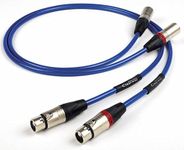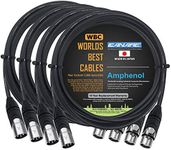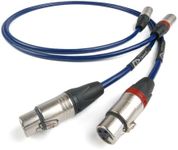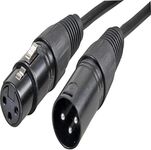Buying Guide for the Best Xlr Cables
When choosing XLR cables, it's important to consider the specific needs of your audio setup. XLR cables are commonly used in professional audio environments for microphones, mixers, and other audio equipment due to their balanced audio signal, which reduces noise and interference. Understanding the key specifications will help you select the right cable for your needs, ensuring optimal performance and durability.Cable LengthCable length is crucial because it determines how far you can place your equipment from each other. Shorter cables (1-10 feet) are ideal for studio setups where equipment is close together, minimizing potential signal loss. Medium-length cables (10-25 feet) are versatile for both studio and live settings, offering a balance between reach and signal integrity. Longer cables (25 feet and above) are necessary for larger venues or stages but may require higher quality to prevent signal degradation. Choose a length that provides enough reach without excessive slack, which can lead to tangling and clutter.
Cable ShieldingShielding is important as it protects the audio signal from external interference, such as radio frequencies and electromagnetic interference. There are three main types of shielding: foil, braided, and spiral. Foil shielding is lightweight and offers basic protection, suitable for fixed installations. Braided shielding provides better protection and durability, ideal for live performances. Spiral shielding offers flexibility and is good for applications where cables are frequently moved. Consider the environment where the cable will be used to determine the level of shielding needed.
Connector QualityThe quality of the connectors affects the durability and reliability of the cable. High-quality connectors are typically made from materials like gold or nickel, which resist corrosion and provide a stable connection. Look for connectors with a solid build and good strain relief to prevent damage from bending or pulling. If you frequently connect and disconnect your cables, investing in robust connectors will ensure longevity and consistent performance.
Cable GaugeCable gauge refers to the thickness of the wire inside the cable, which affects its ability to carry the audio signal. Thicker cables (lower gauge numbers) can carry signals over longer distances with less resistance, making them suitable for long runs. Thinner cables (higher gauge numbers) are more flexible and easier to handle, ideal for short distances. Consider the distance and flexibility requirements of your setup when choosing the cable gauge.
Balanced vs. UnbalancedXLR cables are typically balanced, meaning they have three conductors: positive, negative, and ground. This configuration helps cancel out noise and interference, making them ideal for professional audio applications. Unbalanced cables, which have two conductors, are more susceptible to noise and are generally used for short runs in less critical applications. For most professional and live sound environments, balanced XLR cables are the preferred choice to ensure clean audio transmission.














